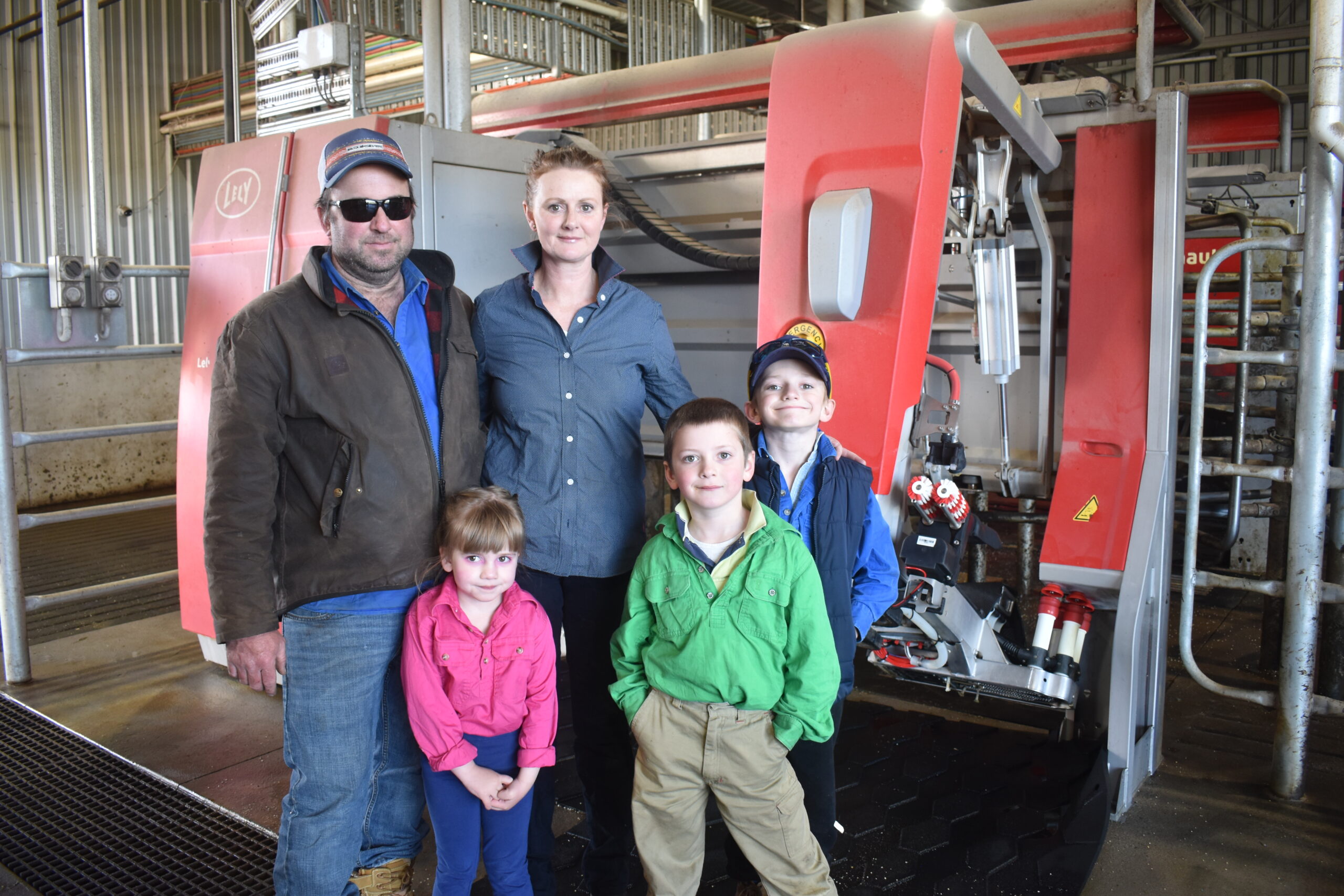App helps choose best traits for robotic milking
Tuckett family
Region: Western Victoria
Topic: Good Bulls App
The genetic traits Tori Tuckett wants in a bull have changed considerably in the past year. And thanks to DataGene’s Good Bulls App she’s able to discover what she needs fast and efficiently.
The evolution of Tori’s breeding philosophy comes after she and her husband Ryan embarked on robotic milking.
“In September, last year, when we started our robotic dairy, it became evident on the day of start-up that some of the traits we had been breeding for, were not ideal for a robotic herd,” she said.

Tori and Ryan Tuckett with their children Lucy 4, Jack 7 and Paddy 6. DataGene’s Good Bulls App is helping the Tucketts breed cows suited for their robotic milking system.
“For example, a lot of our focus now is on rear teat placement and teat length. If cows have close rear teats and their teat length is shorter, it doesn’t work in this system. That’s why we use the app for a guide; it has become a very important tool for us.”
The Terang dairy farmers used the Good Bulls App previously but now it’s on high rotation as Tori investigates new bull options which could suit robotic milking.
“I’d be on that app five-to-six times a week,” she said.
“I might find a bull that’s being used in American and Canadian robotic herds, and I’ll go straight to the Good Bulls App to see how that bull works in our herds over here.”
Bulls that “tick all the boxes” are then researched further, with Tori asking farmers on social media about their experiences with certain genetics in robotic milking systems.
Thoroughly exploring options, and understanding fellow farmers’ experiences, are vital for Tori and her family as they navigate the “emerging” robotic milking system in Australian pasture-based systems.
The Good Bulls App enables users to set their own filters for traits which suit their dairy business.
Tori’s filters are concentrated on teat length, teat placement, mammary system, dairy strength, milking speed and temperament.
“Milking speed is really important because it correlates to box time – the time each cow spends in the robot,” she said.
“We don’t want a long box time, but we also don’t want extreme milk speed because that comes with its own issues. We set the filters at 101 or 102, anything 100 and under we don’t want because they milk too slow.”
Temperament is something the Tucketts are still considering.
On one hand, training cows to milk via robot is easier if they are quiet because cows kicking robots causes damage to the system and robot failures, but cows also need to be motivated enough to walk through a herd and make their way into a robot for milking.
The Tucketts milk 750 cows, 550 through eight robots and the remainder in their rotary dairy.
Tori said some cows remained in the rotary herd because they weren’t motivated enough for the robotic system – they’d stand for 15 hours a day, rather than push forward for milking.
Others are in the rotary herd because they have traits that are desirable in a traditional milking system – such as a tight central udder ligament – but don’t work well with robots.
“The extreme tighter central ligament can result in Rear Teat placement becoming too close,” Tori said.
“We are using the app to make sure we retain ligament with correct Rear Teat placement.”
Overcoming labour challenges was the driving force behind the Tucketts move to robotics. But they have realised other benefits from the technology.
The robotic herd – 10 months into the new system – was producing 23% more milk solids.
“It is a lot more efficient way of milking cows,” Tori said. “For example, if one quarter is a lot lighter, the robots would take that cup off and keep milking the other three quarters.”
The Good Bulls App is also a useful tool to guide semen inventory stocktake.
Tori said she regularly checks the semen in the AI tank against information on the app and even glances at the app “quickly” just before breeding cows. This last-minute app check is for reassurance; Tori likes to be 100 per cent sure that the key traits of a bull are an ideal match for the recipient cow.
Calving year-round, the Tucketts are always on the lookout for bulls that suit their system and developing their breeding philosophy is a work in progress.
“There’s still a lot of work to do,” Tori said.
“When this year’s spring group starts calving in, we might realise there are some more traits that we need to look at, something else to focus on. We are continually learning.”


